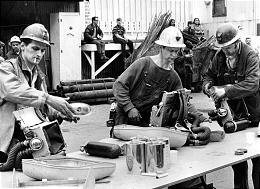
It's May 2, 1972. Eight miles southeast of Kellogg, Idaho a fire of undetermined origin was detected in the Sunshine Mine, the world's largest silver producing mine. At the onset, eighty-one men were evacuated from the mine, but ninety-three were not. Ninety-one men died from smoke inhalation or carbon monoxide poisoning. Two men, Ron Flory and Tom Wilkinson, were rescued seven days later. The men pictured above were rescuers, grimly preparing to descend into a mine where workers were known to have been working as far as 5200 feet underground. Look at these men's faces. The men are young, but their faces are worn and anxious, but also almost matter of fact, like they've been down this road before. I'm struck by the casual posture of the two guys sitting in the center of the background. With men dying underground, they look they might be talking about how elk hunting went last winter or whether prices on the Honda 750 might finally come down this spring. In the deeper background, I see at least one woman, maybe three. Their husbands haven't surfaced yet, I'll bet.
This look on the rescuers' faces was a look found throughout the Silver Valley, catastrophe or not. In a videotape featuring interviews with survivors of the mine, conducted thirty years after the fire, a victim's daughter praises the character of the people of the Silver Valley, saying that "when disaster hits the Valley people come out the woodwork to help". Listening to her, now that I'm an adult and haven't lived in the Valley since 1976, I'm struck that she didn't say if disaster hits, but when it hits. I know what she means. Floods, forest fires, rockbursts in mines, mine fires, drunken motor vehicle pile ups, car wrecks up and down the North Fork of the Cd'A River, knife fights, and the daily dangers of working to mine the earth of ore or work in mills to smelt it combined to make disaster and death common in the Silver Valley.
My sister and I agree that no matter where we are, we can often spot someone who lives in Kellogg or used to because they have the Silver Valley Look. It's a lined, haunted, tired, anxious, weary, unsure, melancholy look. It often lies just beneath the surface of warmth, joviality, and laughter. Sometimes the laughter goes overboard and is akin to sobbing. A professor in the University of Idaho group I spoke to in Wallace said I was describing the look of Post Traumatic Syndrome. I could see that, but for the men in this picture, the trauma's not only "Post", it's in the moment and there's more to come. Those of us who worked in the Zinc Plant cell room knew in the back of minds that we were always one careless move away from serious electric shock, sulfuric acid burns, having a leg broken by a load of zinc-covered cathodes, or suffering a serious cut from the razor edges of the zinc we stripped off the cathodes. We laughed. We horsed around. We spoke lots of smack. We bitched and moaned. We were sarcastic, hungover, wearied by our work. The strain of always holding danger at bay and leaving work to inhale the polluted air our very work was helping bring about takes its toll, and it shows in the face.
No comments:
Post a Comment